Circling the Drain: Tackling Europe’s Strangest Roundabout in an Audi R8
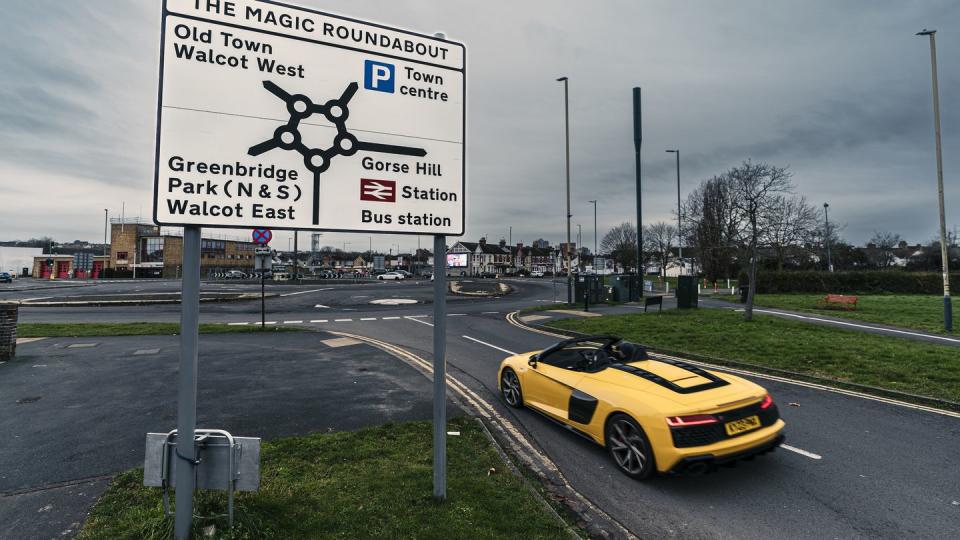
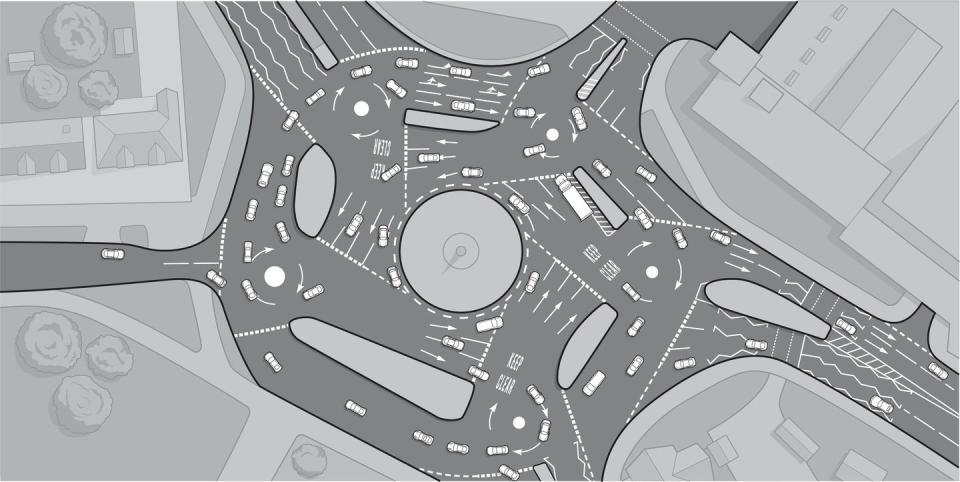
Ask somebody to nominate Europe’s toughest driving adventure and they are likely to suggest an Alpine pass or maybe a high-speed run on a derestricted autobahn. But a suburban intersection in England also deserves consideration, especially for anybody unfamiliar with roundabouts. Swindon’s so-called Magic Roundabout combines no fewer than six rotary junctions into one confusing whole. And if that’s not challenge enough, it also allows drivers to navigate it in both directions.
Do not ask me to give you a complete history of the roundabout. It is a rabbit hole of dueling claims between New York’s Columbus Circle (opened in 1870 and redesigned in 1905) and Paris’s infamous Place de l’Etoile, an intersection of 12 roads with the Arc de Triomphe in its center. (It is older than its American counterpart—inaugurated in 1836—but vehicles were allowed to pass around it both ways until 1907.)
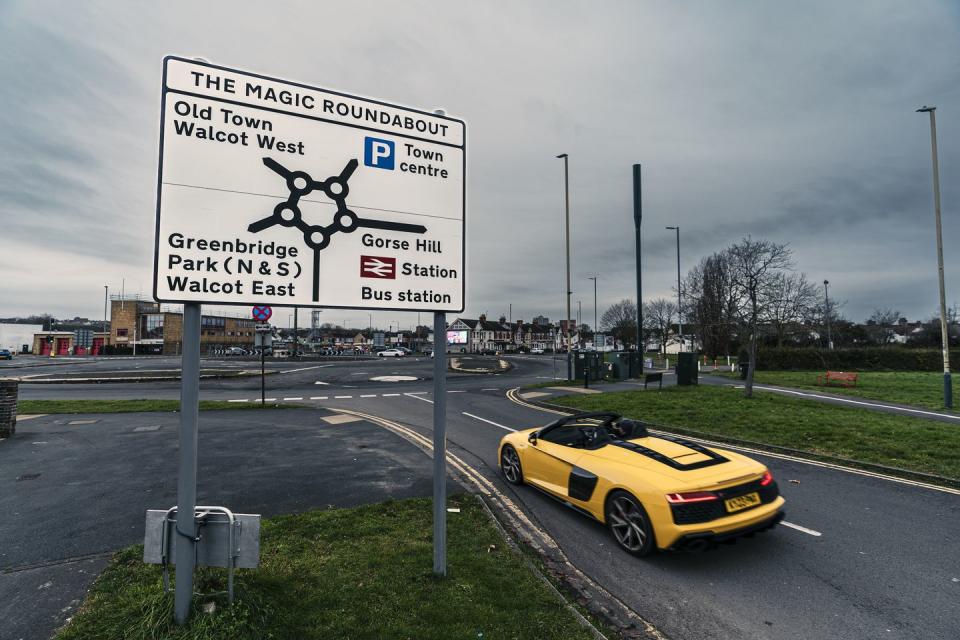
What is clear is that the roundabout did not start life with a good reputation. As the automobile brought more streets, many more traffic circles followed. Order did not. These early circles were essentially a continuation of all the roads that joined them rather than a conventional intersection, meaning there was no need to stop or yield on the way onto them. Vehicles entering a circle had priority, but without any marked lanes, aggressive drivers would often swerve and weave around slower ones. Most of the early examples of traffic circles in the U.S. had been replaced by conventional intersections by the Fifties.
But not in Europe, where an important innovation created the orderly modern roundabout. Enter the hero of this story, a former RAF officer turned traffic engineer called Frank Blackmore, who spent more than 20 years working for the Transport and Road Research Laboratory in the U.K.. Blackmore was a superstar of traffic management, his passion for the subject so deep he would often take his family on vacation to foreign destinations chosen so he could study road design.
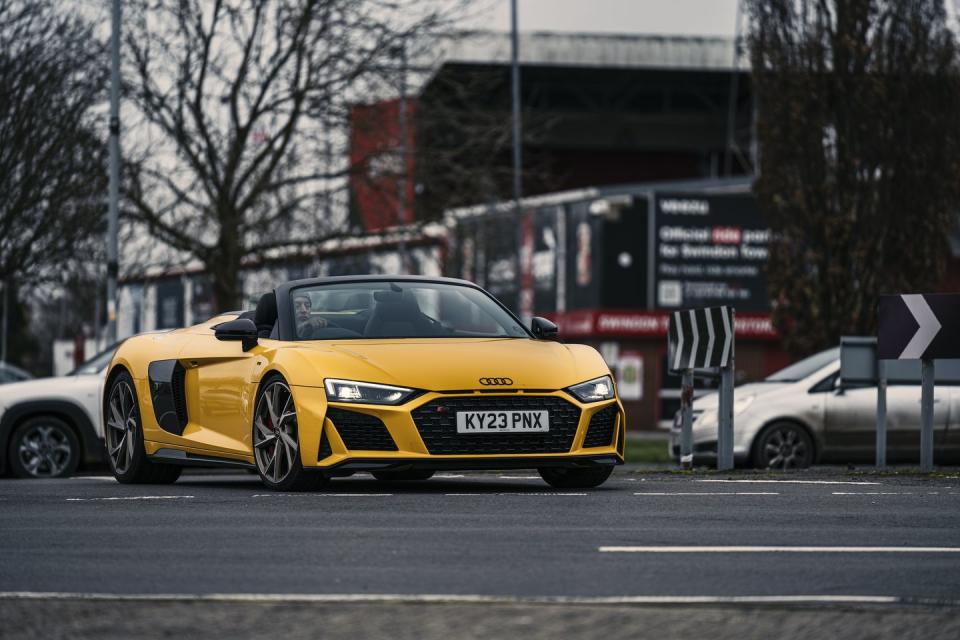
Blackmore’s first radical change was introduced to Britain in 1966: making vehicles heading onto a roundabout yield to those already on it. He was inspired by seeing the opposite system at work in France, as noted in his beautiful obituary on—and I absolutely love that this is a real website—mini-roundabout.com. This simple change, often combined with the addition of lane markings, improved flow and safety. It worked so well that it soon spread to other countries. Even haughty France, rarely keen on taking advice from well-meaning Brits, adopted this changed priority as default for its roundabouts. Although not at the Place de l’Etoile, which continues with the old way.
When some U.S. states began the limited introduction of roundabouts in the Nineties, they adopted this yield-on-entry approach too, and the surviving original traffic circles were also changed to it. As a result, and with much less risk of side-on collisions (and very little chance of a head-on), roundabouts are much safer than conventional intersections. According to a Dutch study cited by the Federal Highway Administration’s helpful explainer on roundabout design, vehicle occupant injuries fall by up to 95 percent when roundabouts are introduced.
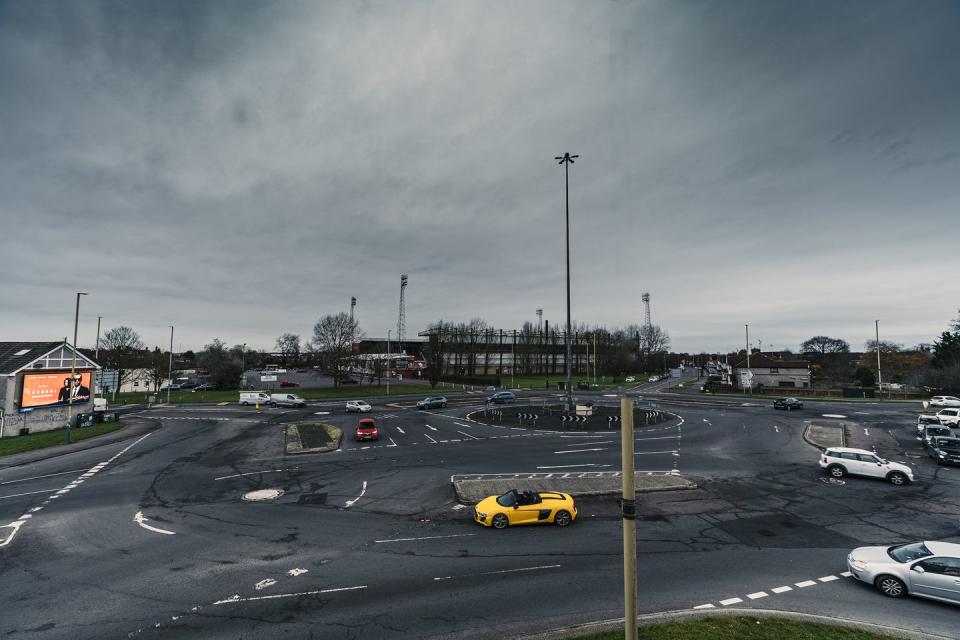
Blackmore had already secured a place in the pantheon of traffic managers, but he was not finished. The biggest problem with converting existing intersections to roundabouts was the space required by a roundabout’s central hub. This made it hard to use them in tight-fitting urban areas without radical alterations. So Blackmore created a smaller roundabout without any central median—traffic flow was regulated by nothing more than painted markings and with a low bump in the middle that vehicles could pass over. The first of these mini-roundabouts was built in Peterborough, England, in 1969. On its opening day, Blackmore himself stood next to it with a loud-hailer to instruct bemused drivers how to negotiate it.
But Blackmore had more to give, and it was in Swindon—a mid-size English town around 70 miles west of London—that he constructed his masterwork. This is an intersection that, even after more than 50 years of operation, is still often spoken of in both fear and respect. Officially known by street planners as a “ring junction,” this pioneering example has long been called the Magic Roundabout.
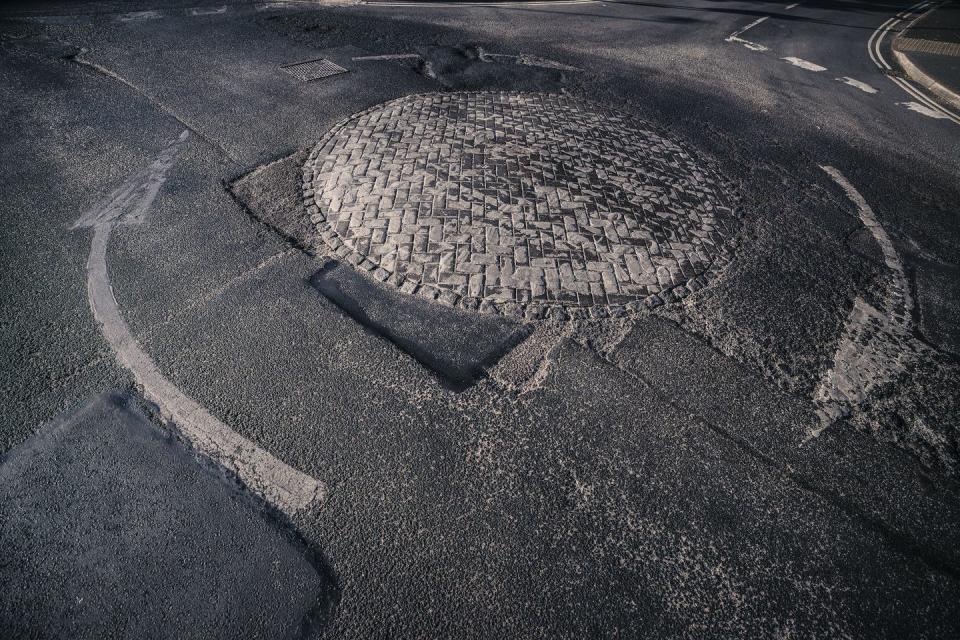
While the conventional roundabout is more efficient than a stop-and-go intersection, it still has a problem in that vehicles have to orbit it to reach their exit. So if one road gets choked up, then the roundabout itself will quickly become jammed with road users waiting for that exit and blocking others from joining. In Swindon, Blackmore combined both of his earlier innovations and created a five-way intersection that uses five mini-roundabouts around a central island. Each of these mini-roundabouts is negotiated in the correct direction—clockwise in drive-on-the-left Britain—but a driver is free to go around the center either way to reach their exit.
This magnificent example of traffic management opened in 1972 and was officially dubbed the County Islands roundabout. But locals (or perhaps a visiting reporter, argues the BBC) soon renamed it after a psychedelic kids’ TV show from the period that featured a guitar-playing hippy rabbit and a magical jack-in-the-box. The new name stuck so hard that it became official in the Eighties. Now visitors to Swindon will find the Magic Roundabout signposted throughout the town, possibly so they can avoid it. Even in Britain, where there are thousands of roundabouts, this one still regularly features high on the surveys of the country’s most feared roads.
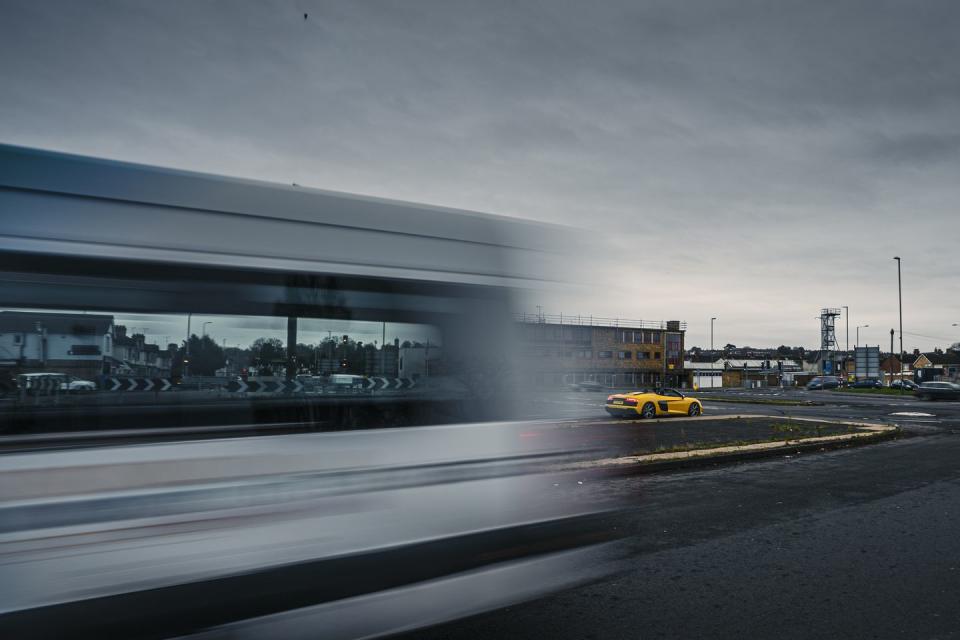
As a driving challenge, the Magic Roundabout is an anti-climax, even in a bright yellow Audi R8 Spider that we had already borrowed to shoot an obituary for the charismatic sports car. Concentration is required, but no great skill is necessary beyond the challenge of working out where lanes lie between faded markings.
With a careful choice of apex points, it is often possible to carry impressive speed around Britain’s larger conventional roundabouts, but that definitely isn’t the case here. The number of separate yield lines for the constituent mini-roundabouts means the need for frequent pauses to check for other vehicles. The need to do something unfamiliar still takes acclimatization and brings a caution that limits speed. I also discover the need to think ahead: To properly use the Magic Roundabout you need to exit each of the mini-roundabouts in the correct lane for whichever maneuver you are planning to make at the next one. But even when I fail to do this, the local drivers seem tolerant of my mistakes and let me in. They must be used to star-struck outsiders, although probably not ones in nuclear yellow sports cars.
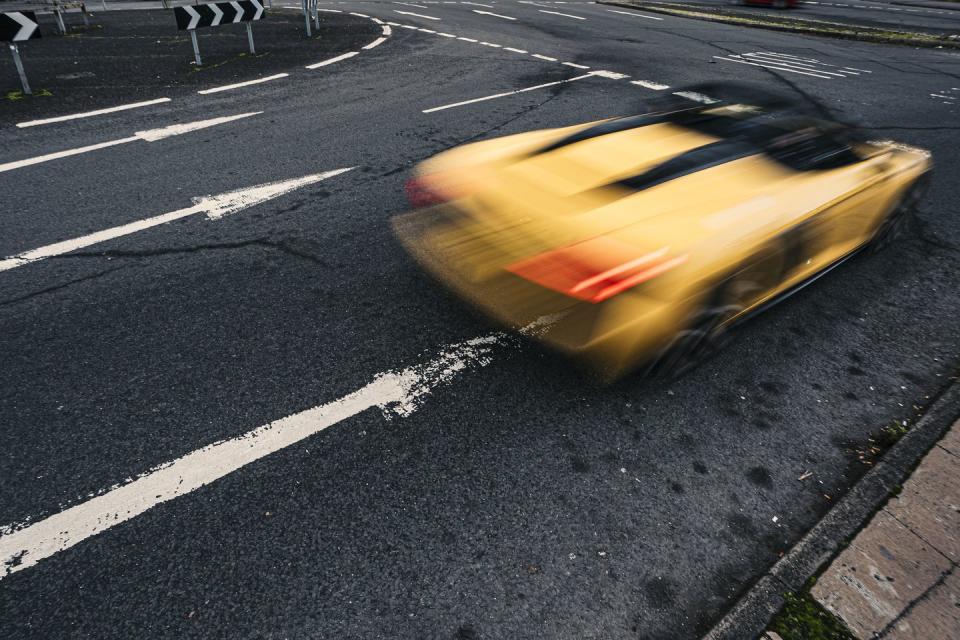
Traveling in what feels like the wrong direction around the central median is a strange sensation. Entering from the south and wanting to head east would, on a normal British roundabout, require traveling most of the way around it. Here I just need to turn right at two mini-roundabouts. Yet as confidence builds slightly, I come close to an embarrassing mistake—that of trying to navigate around the central circular island in the clockwise direction of a normal British roundabout. Because in the same way that meshed gears drive each other in opposite directions, the mini-roundabouts mean that any vehicle orbiting the center of the Magic Roundabout has to do so counter-clockwise, like I would in America. I notice in sufficient time to avoid becoming a minor local celebrity as the man who smashed up a $200,000 sports car on Swindon’s most famous bit of road.
Beyond the risk of my poor observational skills, the Magic Roundabout seems to work well. Traffic flows freely through the complex layout and without any honked horns or other signs of frustration. Despite its unfamiliarity for many drivers, maybe because of it, the Magic Roundabout has proved itself to be impressively safe. During its first 25 years of operations, there were 14 accidents deemed serious on it and 100 minor fender-benders. That’s fewer than would be expected for a similarly sized conventional roundabout. More recently, it has been ringed with bicycle lanes to keep cyclists away from cars and reduce risk further.
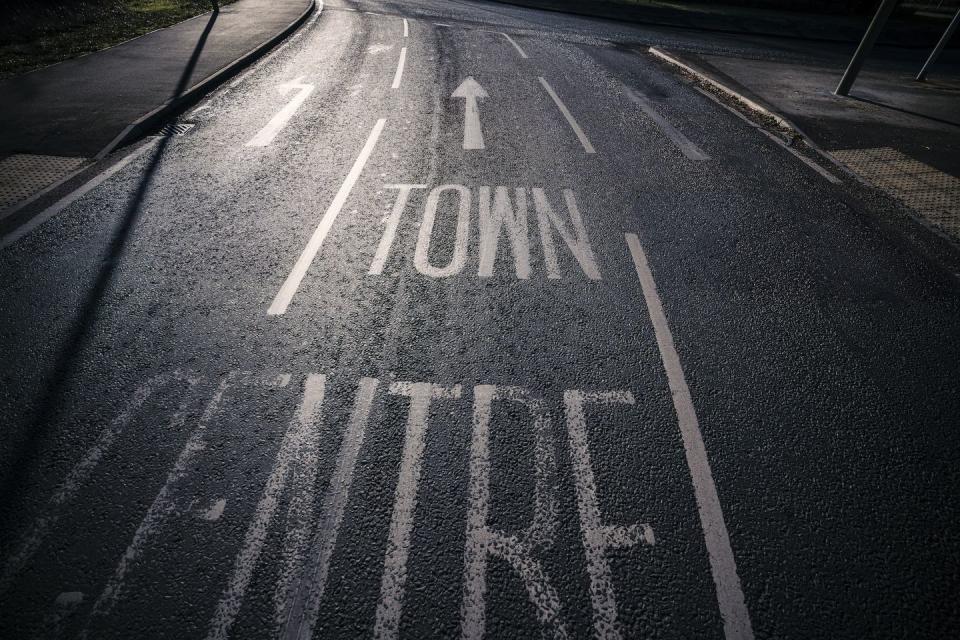
Local inhabitants have a definite pride in their landmark, although one we spoke to struggled to understand why we would choose to visit with an Audi R8: “If I had a nice car like that I’d take it to a nice road, not drive round in bloody circles.” But the fish-and-chip shop next to it is called the Magic Chippy, Britain’s Roundabout Appreciation Society has run trips to see it, there is Magic Roundabout merchandise, and it has even been used as the site of a Red Bull drifting video.
The Magic Roundabout also faces competition from elsewhere in the U.K., with several other multipart roundabouts following Blackmore’s design. One, 85 miles from Swindon in Hemel Hempstead, beats it for complexity with six constituent mini-roundabouts. But that one was opened a year later; Swindon’s is the original.
Roundabouts are on the rise in the U.S., with a growing number of states starting to introduce or reintroduce them. California has even started to build so-called “turbo roundabouts,” featuring curb-separated lanes (and a vaguely turbine-shaped median) to make it easier for drivers to work out where to go. But will we ever reach the pinnacle of rational road design that is the Magic Roundabout?
You Might Also Like

 Yahoo Autos
Yahoo Autos 